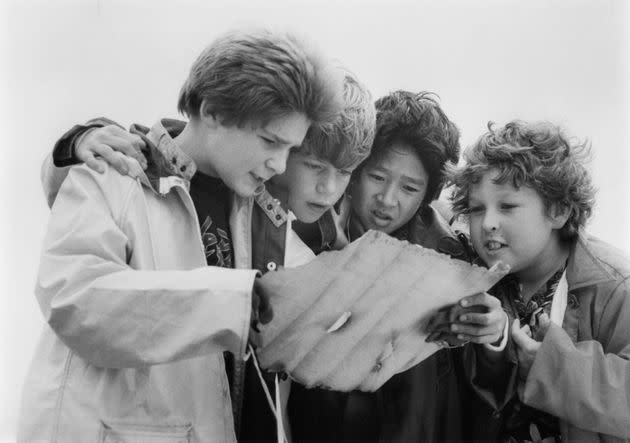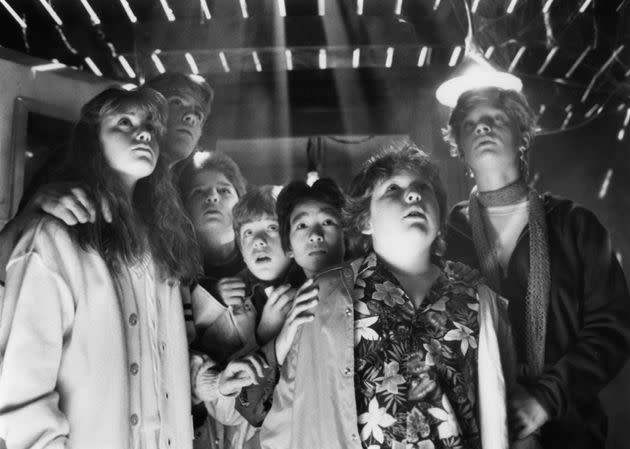Shipwreck That Inspired 'The Goonies' Potentially Discovered In Oregon
Goonies never say die, but the mystery of One-Eyed Willy’s pirate ship might just have been put to rest.
Volunteer archaeologists spelunking along the Oregon coast in June found more than 20 timbers they think belonged to a Spanish ship that inspired the 1985 film “The Goonies,” according to The Washington Post. And while its discovery may not have been as adventurous as the film itself, reaching the cavernous site was a feat in its own right.
“No booby traps, just timbers,” Scott Williams, president of the Maritime Archaeological Society, told the Post. “The caves are incredibly hard to get to. They are located on a beach that is only accessible at high tide, and it’s a tough hike to get to it over landslides and boulder fields.”

Nearly 40 years after "The Goonies" hit theaters, volunteers found remnants of the iconic ship that inspired its on-screen treasure hunt. (Photo: Michael Ochs Archives via Getty Images)
Produced by Steven Spielberg and written by Chris Columbus, “The Goonies” follows a ragtag group of kids hunting for the lost treasure of One-Eyed Willy — a pirate whose gold-laden ship was hidden inside a cave.
The Santo Cristo de Burgos galleon was ultimately carrying beeswax when it capsized in the Pacific Ocean in 1693, according to CNN. Nonetheless, its resting place — known as the Beeswax Wreck — has mystified historians and inspired storytellers like Spielberg and Columbus ever since.
While researchers have yet to confirm whether these newly discovered timbers belonged to the Santo Cristo de Burgos, historians believe it sank off the Oregon coast. Locals even saw beeswax, which was used to make silks and Chinese porcelain, wash ashore shortly after the ship vanished, according to the Post.

Steven Spielberg was so fascinated by the Spanish galleon that he set "The Goonies" in Astoria, Oregon, where remnants of the wreck have washed ashore for centuries. (Photo: Michael Ochs Archives via Getty Images)
“We’re about 90% sure they are, but there is nothing definitive that we’ve seen that says they are from the ship that went missing in 1693,” Williams told the Post. “It’s some kind of ship built in Asia or possibly South America, which would have been the case with the Santo Cristo de Burgos. There’s a chance it’s an unknown shipwreck, but the odds are small for that. The simplest explanation is that these timbers are part of the galleon.”
Local tribes have even orally handed down histories of a sinking and recalled beeswax blocks with Spanish engravings and shattered porcelain washing ashore since the 1700s in what is now Astoria, Oregon, according to National Geographic.
“Both offer strong clues that this was a Spanish galleon,” Williams told the Post. “The Chinese porcelain is important. That was a luxury good where the designs changed every 10 or 20 years. We can tell this porcelain was made between 1680 and 1700, which helps us date when the ship wrecked.”
It ultimately took a local looking for gemstones along the coast in 2020 to spot the pieces of timber and alert officials for the search to get underway. It then took nearly two years for Williams and his team to unearth the wood amid pandemic lockdowns and volatile tides.
Next, Williams said, the plan is to “do some diving” near the wreck, including with an “underwater remote-operated vehicle with a camera.”
“We’re hoping that one of our divers will stumble on a Spanish cannon laying on the ocean floor,” Williams told the Post. “That would be pretty exciting!”
This article originally appeared on HuffPost and has been updated.

